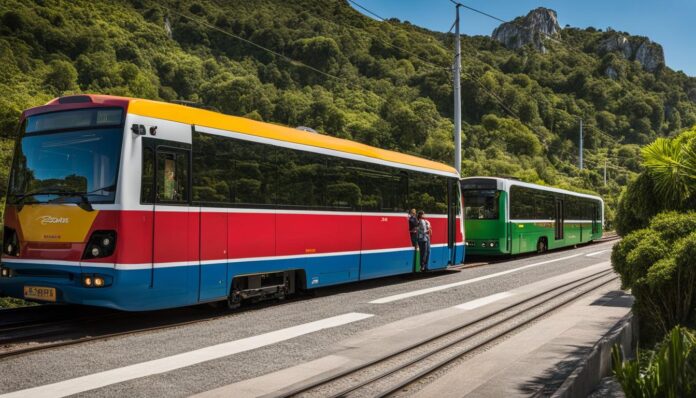Are you planning a trip to Sintra but unsure whether to travel by train or bus? With multiple transportation options available, deciding which one is better can be a daunting task. In this article, we will explore the pros and cons of each mode of transportation and help you find the most convenient and cost-effective option for your Sintra adventure!
Traveling by train or bus to Sintra has its own advantages and disadvantages. While train travel offers scenic views and comfortable amenities, bus travel may be more flexible and affordable. You need to prioritize your preferences and travel requirements to select the option best suited for you.
Keep reading to learn more about each transportation option and their benefits and drawbacks.
Is it better to visit Sintra by train or bus? Let’s explore and answer this question together!
Pros and Cons of Traveling by Train to Sintra
If you’re trying to decide whether to take the train or bus to Sintra, it’s important to consider all your options before making a decision. Here are some pros and cons of choosing the train as your mode of transportation to Sintra:
| Pros | Cons |
|---|---|
| Speed: Trains are generally faster than buses, making them a good option if you’re pressed for time or only have a short visit planned in Sintra. | Cost: Trains can be more expensive than buses, particularly during peak travel seasons. |
| Comfort: Trains often provide more legroom and amenities, such as wifi and food and beverage service, making for a more comfortable journey. | Flexibility: Trains run on a fixed schedule, which may not align with your preferred travel times or itinerary. |
| Scenery: Train routes can offer breathtaking views of the surrounding landscape, providing a unique and enjoyable travel experience. | Crowds: Trains can be crowded, especially during peak travel times, making it difficult to secure a seat or find space for luggage. |
Keep in mind that while the above factors are relevant considerations, the experience of traveling is highly subjective and based on your personal preferences and priorities for your trip to Sintra.
Another important factor to note is that the Sintra train station is centrally located, making it easy to access other popular destinations in the area, such as the coastal town of Cascais or the capital city of Lisbon.
Benefits and Drawbacks of Taking the Bus to Sintra
If you’re exploring your transportation options to Sintra, taking the bus can be a convenient and economical solution. Whether you’re traveling on a tight budget or getting around without a car, here are some advantages and disadvantages to keep in mind when it comes to taking the bus.
Pros of Taking the Bus to Sintra
- Affordability: One of the biggest advantages of taking the bus to Sintra is the cost. Bus fare is generally cheaper than train tickets, making it an attractive option for thrifty travelers.
- Flexibility: Buses to Sintra run frequently throughout the day, providing passengers with added flexibility when it comes to scheduling. With a little research, you can easily find an ideal time to depart and avoid peak travel times.
- Convenience: Taking the bus can drop you off directly near Sintra’s major attractions, making it a particularly convenient choice for travelers who don’t want to walk long distances or carry luggage.
Cons of Taking the Bus to Sintra
- Inconvenience: Since buses make frequent stops along the route, the travel time to Sintra can be longer than taking the train. If you’re on a tight schedule or prefer a quicker mode of transportation, this might not be the ideal route for you.
- Crowded: During the peak season, buses to Sintra can become quite crowded, leading to a less comfortable travel experience.
- Less Views: While taking the bus to Sintra doesn’t mean you’ll miss out on all the beautiful scenery, certain routes may not provide the same sweeping landscapes as the train.
In summary, taking the bus to Sintra has its benefits and drawbacks. It’s a great choice if you’re trying to save money or desire a more flexible travel option. However, if you’re looking for a more comfortable or faster way to reach your destination, you might want to consider taking the train instead.
Cost Comparison: Train vs. Bus to Sintra
For many travelers, the cost is a significant factor when choosing a mode of transportation. Let’s take a closer look at the costs associated with both options to help you decide which one works best for you:
| Transportation Method | Price Range | Notes |
|---|---|---|
| Train | $2.25 – $3.00 (one-way) | – Tickets can be purchased online or at the station – Discounts available for seniors and children – More expensive during peak travel times – No extra fees for luggage |
| Bus | $5.00 – $6.25 (round trip) | – Tickets can be purchased directly from the driver – Discounts available for seniors and children – More affordable during peak travel times – Additional fees for luggage |
As you can see, the bus is generally more expensive than the train to Sintra, but there are discounts available for children and seniors. During peak travel times, the train may be more expensive, so it’s essential to check the fares before booking. It’s also worth noting that the bus charges additional fees for luggage, so keep that in mind if you’re traveling with several bags.
Tip: If you’re looking to save some money, consider taking the train during off-peak hours or opting for the bus if you’re traveling with someone who qualifies for a discount.
Convenience and Accessibility: Train or Bus?
When it comes to traveling to Sintra, the convenience and accessibility of your chosen mode of transportation is of utmost importance. Whether traveling by train or bus, you want to ensure a smooth journey from start to finish.
One of the key factors to consider is the frequency of service. Trains to Sintra run regularly and at fixed hours, while buses have more flexible schedules, allowing you to choose the best time for your trip. Additionally, trains tend to stick to a more direct route, while buses may have more stops and take longer to reach Sintra.
Another factor is the ease of reaching top attractions. While both trains and buses have stations in Sintra, some popular tourist spots may be easier to reach by one mode of transportation over the other. For example, the Sintra National Palace is easily accessible by bus, while the Regaleira Estate is closer to the train station.
Ultimately, the preferred method of travel to Sintra will depend on your individual needs and priorities. If you value flexibility and convenience, taking the bus may be the better option. However, if you prefer a more direct route and fixed schedules, the train may be a more suitable choice for your trip.
Comparison of Train and Bus Convenience and Accessibility
| Train | Bus | |
|---|---|---|
| Frequency of Service | Regular and fixed hours | Flexible schedules |
| Route | Direct | May have more stops |
| Access to Popular Attractions | Closer to some attractions | Easier access to others |
Comfort and Amenities: Train vs. Bus
When it comes to traveling to Sintra, comfort and amenities are important factors to consider before selecting your transportation option. Taking a closer look at the options for train and bus travel to Sintra can help you determine which mode of transportation is more comfortable and offers more amenities to meet your needs.
Train Travel to Sintra
If you prefer comfort and convenience when traveling, taking the train to Sintra might be the best option for you. Trains to Sintra typically offer more space to move around and more comfortable seats than buses. In addition, many trains also offer amenities such as air conditioning, power outlets, and Wi-Fi, making your travel experience more enjoyable.
One important thing to note is that there are two types of train travel to Sintra. The first option is taking the regular suburban train from Lisbon to Sintra, which is more affordable but can become crowded during peak hours. The second and more expensive option is taking the tourist-oriented “Sintra Express,” which offers a more comfortable experience with fewer stops.
Bus Travel to Sintra
If you prefer a more affordable option, taking the bus to Sintra might be the best choice for you. Buses typically offer lower fares than trains, making them an attractive option for budget-conscious travelers. However, buses can be less comfortable than trains, with less legroom and sometimes cramped seating arrangements.
Despite these differences, modern buses to Sintra often provide amenities such as air conditioning and Wi-Fi. Additionally, the bus routes offer stunning views of the surrounding countryside and coastline, which can make for a memorable travel experience.
| Comfort and Amenities | Train | Bus |
|---|---|---|
| Seat Space | Generally more space to move around and comfortable seats | Less legroom and sometimes cramped seating arrangements |
| Amenities | Air conditioning, power outlets, and Wi-Fi, particularly on tourist-oriented trains | Air conditioning and Wi-Fi on modern buses |
| Cost | More expensive overall but has budget-friendly options | More affordable overall but can be less comfortable |
Overall, choosing between train and bus travel to Sintra will depend on your personal priorities and budget. While trains are generally more comfortable and offer more amenities, buses can be more affordable and offer beautiful views of the Portuguese countryside.
Scenic Routes: Train or Bus to Sintra?
As you plan your trip to Sintra, you might be wondering whether to opt for the train or bus when it comes to enjoying picturesque routes. Both options have their own unique charms, and your choice will depend on what you’re looking for.
If you choose to take the train, you’ll be able to admire the stunning scenery from the comfort of your seat. The train journey to Sintra is a popular tourist attraction, offering breathtaking views of Sintra’s lush forests and countryside. Whether you’re traveling during the warmer or cooler months, you’ll have a chance to enjoy the stunning visuals.
On the other hand, if you opt for the bus, you’ll experience a more dynamic and interactive journey. Buses follow winding routes through the town’s narrow streets, and you may have a chance to see sights you wouldn’t otherwise notice. As an added bonus, some bus routes make stops at local attractions along the way.
Given the merits of both transportation methods, your preference will depend on your personal travel style and what you want to see on your trip. If you enjoy relaxed, passive sightseeing, the train may be the best choice. However, if you’re up for an exciting, immersive experience, don’t hesitate to take the bus.
Whichever option you choose, don’t forget to bring a camera to capture the stunning scenery. Your scenic journey to Sintra will be a beautiful introduction to the fascinating town that lies ahead.
Traveling with Luggage: Train vs. Bus
When deciding how to get to Sintra, it’s important to consider how best to manage your luggage. Depending on the size and weight of your belongings, one mode of transportation may be more convenient than the other.
If you’re taking the train to Sintra, you’ll likely have to navigate through the busy train station with your luggage. While some train stations have escalators or elevators, others may only have stairs, making it difficult to carry heavy bags. Additionally, trains often have limited luggage storage space. If you’re traveling with large bags or suitcases, it may be a challenge to find enough room to store them.
If you’re taking the bus to Sintra, you may have more space to store your luggage. Buses often have designated luggage areas, making it easier to stow your bags. However, you will still need to carry your luggage onto the bus, so be aware of this if you have heavy bags.
Ultimately, the best mode of transportation for you depends on your personal preferences and the amount of luggage you’re carrying.
Conclusion
Now, armed with all the information you need, it’s time to decide whether to travel to Sintra by train or bus. As we have explored in this article, there are pros and cons to both modes of transportation, and it ultimately comes down to your individual preferences, budget, and travel requirements.
If you value convenience and accessibility, taking the train to Sintra might be the best option for you. However, if you’re more concerned about saving money, traveling by bus might be a better fit. Consider the comfort and amenities available, whether you’ll be traveling with luggage, and whether you appreciate scenic routes before making your choice.
By weighing up the factors outlined in each section of this article, you can make an informed decision that fits your specific travel needs. Regardless of which method you choose, we hope you have a fantastic trip to beautiful Sintra.















































